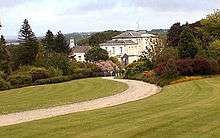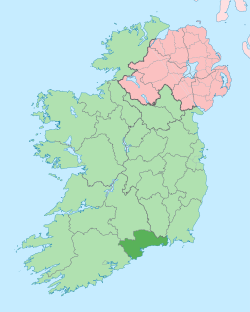Kilmeadan
Kilmeadan[2] or Kilmeaden (Irish: Cill Mhíodáin)[2] is a village in County Waterford, Ireland. It is on the R680 regional road. The town is 36km from Dungarvan and 8km from Waterford.
Kilmeadan Irish: Cill Mhíodáin | |
|---|---|
Village | |
 Residential housing near Kilmeadan Village Centre | |
 Kilmeadan Location in Ireland | |
| Coordinates: 52°14′03″N 7°14′37″W | |
| Country | |
| Province | Munster |
| County | County Waterford |
| Population (2016)[1] | |
| • Total | 259 |
| Time zone | UTC+0 (WET) |
| • Summer (DST) | UTC-1 (IST (WEST)) |
Amenities
Kilmeadan is also the site of St. Mary's Church, a Church of Ireland Chapel, located in the north-western part of the village, Old Kilmeaden, near the railway station, on the R680 regional road towards Carrick-On-Suir.
The school serving the Kilmeadan area is found in Ballyduff, a neighbouring village, which is also home to the Catholic Church of the area, St. Nicholas' Church. Both the GAA and soccer teams of the area are also named Ballyduff Lower GAA and Ballyduff AFC respectively.
Transport
Kilmeadan, lying in a linear pattern along the R680 (former N25 national primary road section), was previously home to a train station on the line from Waterford City to Mallow Junction in County Cork. In 2003 a section of the line was reopened as a narrow gauge attraction, known as the Waterford and Suir Valley Railway.
As part of the new Waterford City bypass, Kilmeadan is now bypassed by a dual-carriageway section of the N25. This brings relief to the previously overcrowded road through the village, now reclassified as R680.
Industry
Throughout much of the twentieth century, Kilmeadan was also home to a farming co-operative. The farmers of the area sold their produce (mostly butter and milk) to the co-op, and as it expanded, a general store was opened in May 1920, which is still present today as a Centra outlet.
In 1964, all of the co-ops in Waterford amalgamated, and was registered as Waterford Co-op. This led to the construction of a cheese factory on a green field site opposite the general store, and Kilmeadan cheese would go on to win a gold and bronze medal in the World Cheese Awards in London in 2005. However, production of the cheese ceased at the Kilmeadan plant in 2005, and the production of Kilmeadan Cheese moved to Ballyragget, County Kilkenny.
Kilmeadan is also the site of the East Waterford Water Treatment Plant. This plant is operated by Waterford County Council and provides water mainly for Waterford City and the surrounding areas.
The area also has a small retail outlet in the Kilmeadan Village Centre, located directly on the R680 in the village. This building provides retails space (for shops) and residential space (rental apartments).
Tourism

_-_geograph.org.uk_-_506657.jpg)
The Mount Congreve estate lies just outside the village, on the Old Kilmeadan Road. Owned and run by the late Ambrose Congreve (1907–2011), Mount Congreve is known for its rare species of plants and plant nurseries. It consists of around seventy acres of intensively planted woodland garden and a four-acre walled garden. In addition there are an 18th-century house (the ancestral home of the Congreve family), a number of glasshouses, more than 16 miles of paths and a wholesale nursery. After Congreves' death, Mount Congreve estate was left to the Irish State. Whilst the gardens are open to the public, the house is not.
Kilmeadan is home to Cullenagh Stables,[3] a livery yard and working farm located on the banks of the River Dawn. Equestrian trails follow woodland and riverside paths, flanked by sites such as the old mill and chimney at Fairbook, the Queen Ann Way - a stopping point on the former Waterford, Dungarvan and Lismore Railway Line, the spa well at Gortnaclode and the remains of the Mill Street houses. Cullenagh formed part of the St Leger (Viscount Doneraile) Estate until 1850. The mill, which first produced paper, was founded by William Phair, who called it after himself, Phair Brook, later to become 'Fairbrook'. By 1824, there were 140 men, women and children working there. It closed in 1840 as a result of a legal dispute. In 1847, Patrick Stephenson bought it and used it during the Great Famine to grind Indian corn. Later he established a woollen mill. In 1875, the mill was taken over by Patrick Stephenson's two sons.
Also on the banks of the River Dawn lies 'Fairbrook House and Gardens'. Seven acres of a former woollen mill have been changed into a walled garden by the Dutch artists Wout Muller and Clary Mastenbroek. Established in 1994, it has evolved over the years and stones from former buildings have been recycled into walls, raised borders, obelisks and standing stones. From May 2003 the small gallery was extended as a museum, for contemporary figurative art.
References
- "Sapmap Area: Settlements Kilmeaden". Census 2016. Central Statistics Office. 2016.
- Placenames Database of Ireland
- http://cullenagh.blogspot.ie
